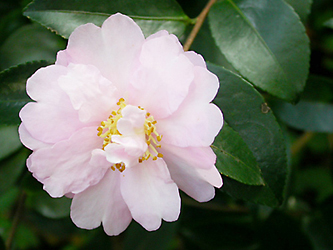

| |
|
|
 |
|
Family: Theaceae (tea family) Common Name: Sasanqua Camellia Origin: China and Japan Camellia sasanquas, like Magnolias, are synonymous with the South. They are frequently found planted in older neighborhoods but are seldom seen in new ones. That’s a shame and a mystery, for these are spectacular plants and deserve a place in every garden. Small plants are inexpensive and easy to find at most nurseries. They can survive periods of neglect and have few pests. Best of all, the plants range in size from short to tall, and the flowers come in colors from white to bright red. Sasanquas are broad-leaved, evergreen shrubs with leathery, dark, rich-green, shiny leaves about 2 inches long - usually darker green and smaller than the leaves of its cousin C. japonica. They are coveted for their flowers, but even if they never bloomed the sasanquas would be prized for their foliage alone. These plants are stunning in a mixed border where they provide Fall and Winter color when little else is flowering in the garden. Though the flowers are smaller than those of its cousin, C. japonica, C. sasanqua is faster growing and has just as much going for it. Tall, single specimens are a natural used as a focal point on lawns and near patios, and low-growing varieties work as a groundcover in shady places and on steep slopes. Wherever you place them, they are sure to make a hit. If you haven’t planted one in your garden or looked at them in your nursery, you’ve really missed out on something good! Don't overlook Camellia sasanqua. Plant one in November and it will be well rooted and off to a great start when spring arrives. Size: Sasanquas have mature heights that range from about 1½ -12 feet tall, but 15 feet is not unheard of if they’re grown under ideal conditions. The taller varieties are typically trimmed up as small trees while other cultivars remain shrubby. Flowers are 1.5-4 inches in diameter and come in single, semi-double and double forms. Though some of the newer varieties are fragrant, most cultivars aren’t. Cultivation: Sasanquas can tolerate many different soil types, but they prefer rich, moist, well-drained, crumbly soil that has been enhanced with organic matter such as peat moss, composted manure and with a slightly acid pH. They are shallow-rooted, so they should not be planted deeply and the soil should not be packed down on their delicate, fibrous roots. It helps to mulch around the plants with organic mulch such as compost, shredded leaves or shredded bark to moderate the ground temperatures. If the leaves lose their dark-green color, an application of the same kind of fertilizer used on azaleas and hollies should restore their beauty. Pruning: These plants have beautiful natural shapes and should need little if any pruning. Cutting out the dead and weak stems can be done anytime, but if you need to trim branches that extend above the outline of the plant or thin the centers of the shrubs to allow air to circulate, it is best to do it in very early spring right after flowering before new buds develop. Light: Filtered shade is preferred, but if they are well-watered, sasanquas will tolerate full sun. As a general rule, the warmer the climate, the less direct sun is needed. Moisture: Sasanquas need adequate water to look their best but, once established, they tolerate greater extremes in moisture than most japonicas. However, overwatering will may cause problems such as root rot or the loss of flower buds. Hardiness: USDA Zones 7 - 9. Sasanquas are somewhat more resistant to low temperatures than the japonicas and new varieties are becoming available with even greater cold-hardiness. Some thought should be put into their placement, though. Flower buds are more likely to be damaged if they become frozen and thaw rapidly, which is more likely if they receive morning sun. Camellias require high temperatures and long days in order to develop their flower buds, but for them to open, cool temperatures and short days are needed. Propagation: Camellias can be grown from seed, but hybrid varieties will not come true that way. If seeds are used, soon after they've matured and have been collected, the seeds should be sown in containers or beds filled with a good potting mixture. Propagating from cuttings is a better method. In late July or August, take cuttings about 4 inches long, remove the lower leaves and dust with rooting hormone powder. Insert them into pots of coarse sand in which a very small amount of peat has been added. Problems:Insects
Some Camellia sasanqua varieties:
|
|
